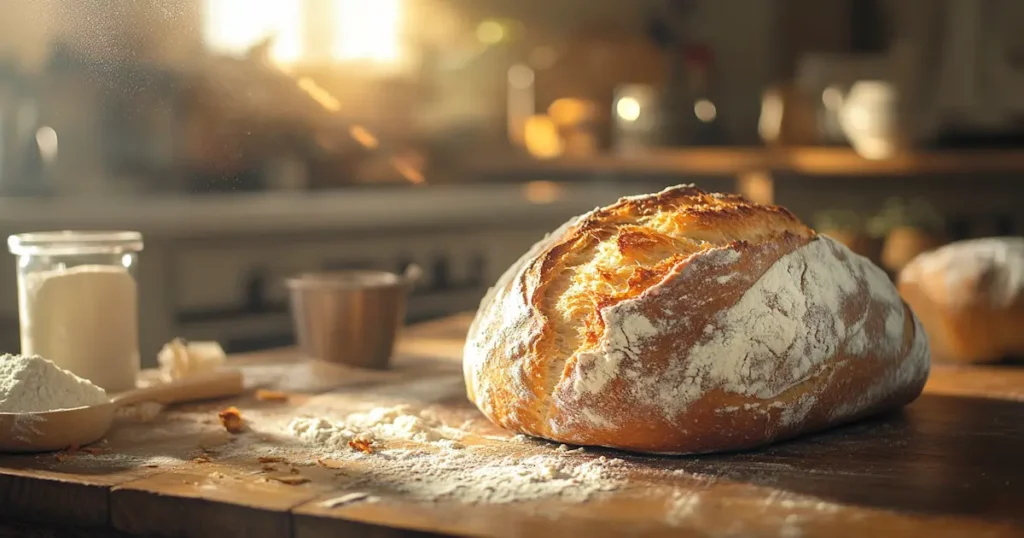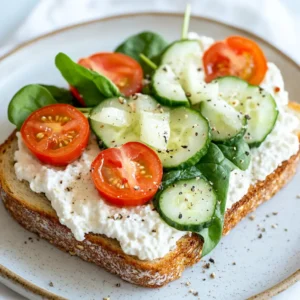The Art of Overnight Bread: A Simple Recipe for Delicious Fresh Loaves
There’s nothing quite like the smell of freshly baked bread filling your home, especially when you’ve put in minimal effort to make it. Traditional bread recipes often require long hours of kneading, resting, and multiple rounds of proofing. But what if you could bake your own delicious, soft bread without spending hours in the kitchen? That’s where overnight bread comes into play.
Overnight bread, or no-knead bread, is a revolutionary method that allows you to create an incredible loaf of bread with very little effort. As the name suggests, all you need to do is mix the dough the night before and let it rise slowly overnight. This long fermentation process results in a bread that is not only incredibly flavorful but also has a light, airy texture and a crispy golden crust. Whether you are a seasoned baker or someone just starting out in the kitchen, this simple technique ensures a perfect loaf every time.
The beauty of overnight bread lies in its simplicity. There are no complicated techniques involved, and the best part is that you don’t need to spend hours kneading the dough. Instead, you can let time do the work for you. All you need are a few basic ingredients—flour, yeast, salt, sugar, and water—and with a little patience, you’ll have a homemade loaf that is far superior to anything you could buy at the store.
In this guide, we’ll walk you through everything you need to know about making the perfect overnight bread. From the basic ingredients to step-by-step instructions, tips for getting the best results, and even variations you can try, this recipe will become your new go-to method for making bread. So, if you’re ready to enjoy the satisfaction of fresh, homemade bread with minimal effort, keep reading!
table of contents
Table of Contents

Key Ingredients for Making Overnight Bread
Basic Ingredients
The beauty of overnight bread is that you only need a few basic ingredients:
| Ingredient | Quantity | Purpose |
|---|---|---|
| Flour | 3 cups (360g) | Base of the dough, providing structure |
| Salt | 1 tsp | Adds flavor and controls yeast activity |
| Yeast | 1/2 tsp (active dry) | Helps the dough rise, creating a light texture |
| Sugar | 1 tsp | Activates the yeast and adds subtle sweetness |
| Water | 1 1/2 cups (355ml) | Hydrates the dough and activates the yeast |
These simple ingredients come together to create a perfect loaf of bread with minimal effort.
Optional Ingredients for Extra Flavor
For added flavor, consider incorporating some optional ingredients:
- Olive Oil: Adds richness and moisture to the dough.
- Herbs: Rosemary, thyme, or garlic powder can be added to the dough for extra flavor.
- Cheese: Shredded cheese can be added for a savory twist.
These additions can personalize your bread and take it to the next level.

Step-by-Step Guide to Making Overnight Bread
Step 1: Mix the Ingredients
Start by combining the dry ingredients—flour, salt, sugar, and yeast—in a large bowl. Stir well to ensure they are evenly distributed. Next, add the water and mix until the dough comes together. It should be sticky but not too wet.
Step 2: Let the Dough Rise Overnight
Once you have mixed the dough, cover the bowl with plastic wrap or a clean towel. Leave the dough to rise at room temperature overnight, for at least 12 hours. The dough will slowly ferment, developing flavor and a light texture.
Step 3: Shape the Dough
The next day, the dough should have doubled in size and be covered in bubbles. Sprinkle flour on your countertop and gently scrape the dough out of the bowl. Shape it into a round loaf or a more traditional shape, depending on your preference. Let it rest for another 30 minutes.

Baking Your Overnight Bread
Preheat the Oven
Preheat your oven to 450°F (230°C). If you have a Dutch oven, place it in the oven while it preheats—this will help the bread develop a nice, crispy crust.
Bake the Bread
Once the oven is preheated, carefully transfer your shaped dough into the Dutch oven or onto a baking sheet. Bake for 40 minutes or until the crust is golden brown and the bread sounds hollow when tapped on the bottom. If using a Dutch oven, remove the lid halfway through baking for the final 20 minutes to allow the bread to brown properly.

Tips for Perfecting Your Overnight Bread (H2)
Use Room Temperature Water
It’s important that the water used for mixing is lukewarm, not too hot or too cold. If the water is too hot, it can kill the yeast, and if it’s too cold, the dough won’t rise properly.
Don’t Skip the Resting Time
Letting the dough rise overnight is essential. The longer fermentation time gives the bread its unique flavor and texture. Skipping this step will result in less flavorful, denser bread.
Bake on a Baking Stone for Extra Crispiness
For a crispier crust, you can bake the dough on a preheated baking stone instead of a baking sheet. This ensures a nice, golden-brown crust.
Variations of Overnight Bread You Can Try
Herbed Overnight Bread
Add dried herbs like rosemary, thyme, or basil to the dough for a fragrant, savory loaf. You can also add minced garlic for a garlic-flavored bread that goes great with pasta or salads.
Cheese and Garlic Bread
For a savory option, add grated Parmesan cheese and minced garlic to the dough before the overnight rise. This creates a flavorful, cheesy loaf that pairs perfectly with soups or as a side dish.
Whole Wheat Overnight Bread
If you prefer a more rustic, hearty bread, try using whole wheat flour instead of all-purpose flour. You might need to add a little more water, as whole wheat flour absorbs more liquid than white flour.
Storing and Serving Overnight Bread
How to Store Your Bread
Once baked and cooled, store your overnight bread in a bread box or wrap it in a clean kitchen towel. It should stay fresh for up to 4 days at room temperature. You can also freeze the bread for longer storage.
Ways to Serve Your Bread
This bread is perfect for sandwiches, toasts with butter or jam, or as a side to your favorite meal. The soft texture and crispy crust make it versatile and delicious.
Common Mistakes to Avoid When Making Overnight Bread (H2)
Don’t Skip the Rest Time
Many people rush the process, but the long rise time is essential for developing the best flavor. If you don’t let it rise enough, your bread will lack flavor and texture.
Avoid Using Too Much Flour
If you add too much flour when mixing or shaping the dough, it can make the bread too dense. Only add flour as needed when shaping the dough to keep it soft and light.
FAQ About Overnight Bread
- Q1: Can I use whole wheat flour for overnight bread?
Yes, you can use whole wheat flour. Just be aware that it will result in denser bread, and you may need to add a little extra water to the dough. - Q2: Can I store the dough in the fridge instead of leaving it out overnight?
You can refrigerate the dough if you want to extend the fermentation period, but be sure to let it come to room temperature before baking. - Q3: How can I make the bread softer?
For softer bread, make sure to use enough hydration and don’t overbake it. Adding a bit of olive oil to the dough can also help keep the bread moist.
Conclusion
In conclusion, overnight bread is the perfect solution for anyone who loves the taste of homemade bread but doesn’t have the time to knead, shape, and wait through the traditional bread-making process. With just a few simple ingredients and a little patience, you can enjoy freshly baked bread that’s soft on the inside with a beautifully crispy crust. This method allows the bread to rise slowly overnight, developing rich flavors and an airy texture that you simply can’t achieve with quicker methods.
The best part about overnight bread is its versatility. You can customize it to suit your taste by adding herbs, cheese, garlic, or even using whole wheat flour for a more rustic texture. Whether you prefer your bread with a simple olive oil drizzle or as the perfect accompaniment to a hearty soup, this recipe is adaptable for all your culinary needs. It’s not just about the bread itself; it’s about creating something from scratch that’s far superior to store-bought alternatives, all with minimal effort on your part.
Overnight bread is not only easy, but it’s also a rewarding experience. The satisfaction of pulling a golden-brown loaf from the oven, knowing that you’ve made it with your own hands (even if it only took a few minutes of work), is incomparable. Plus, the aroma of freshly baked bread filling your kitchen is the kind of simple joy that can’t be replicated by anything else.
So, whether you’re an experienced baker or someone who’s never made bread before, this method is foolproof and will soon become a staple in your kitchen. Don’t let the fear of complicated techniques stop you from trying homemade bread—this overnight recipe will have you baking like a pro in no time. Give it a try, and soon you’ll find yourself enjoying the magic of fresh, homemade bread every week, with no kneading required!
“Love homemade bread? Join our community on Facebook and Pinterest for more delicious recipes, baking tips, and inspiration! Follow us today and never miss a fresh, easy recipe! “
Print
Overnight Bread Recipe: Easy No-Knead Method for Soft and Fluffy Bread
- Total Time: 12 hours 45 minutes
- Yield: 1 loaf 1x
Description
This simple overnight bread recipe requires no kneading and minimal effort. With a long fermentation process, you’ll get a loaf that’s soft, airy, and has a crispy golden crust.
Ingredients
- 3 cups (360g) flour
- 1 tsp salt
- 1/2 tsp (active dry) yeast
- 1 tsp sugar
- 1 1/2 cups (355ml) water
Instructions
- Combine dry ingredients (flour, salt, sugar, yeast) in a bowl.
- Add water and mix until dough comes together, sticky but not too wet.
- Cover the bowl with plastic wrap or a towel, let rise overnight for at least 12 hours.
- Shape the dough the next day into a loaf and let rest for 30 minutes.
- Preheat oven to 450°F (230°C), and if using a Dutch oven, place it inside to preheat.
- Bake dough for 40 minutes or until the crust is golden brown and sounds hollow when tapped.
Notes
Optional: Add olive oil for moisture, herbs for flavor, or cheese for a savory twist.
- Prep Time: 5 minutes
- Cook Time: 40 minutes
- Category: Bread
- Method: Baked
- Cuisine: General
Nutrition
- Serving Size: 1 slice
- Calories: 120
- Sugar: 1g
- Sodium: 200mg
- Fat: 1g
- Saturated Fat: 0g
- Unsaturated Fat: 0g
- Trans Fat: 0g
- Carbohydrates: 25g
- Fiber: 2g
- Protein: 4g
- Cholesterol: 0mg



